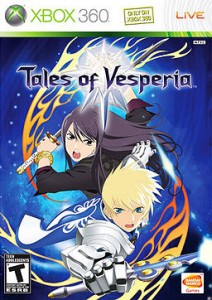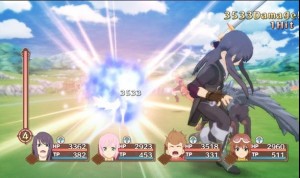
How does one start talking about a game such as Tales of Vesperia? The game, released in 2008 for the Xbox 360, proved to be a significant addition to the Tales series, and a giant leap for the series into high definition. This real-time combat driven role playing game gives players two difference gameplay experiences in one game; players may experience the strategy and statistics of a role-playing game, while experiencing battles in a similar fashion to battle action games. This mix, while not for everyone, gives players a unique experience that can only be expected of the established Tales series.
-Story-
Tales of Vesperia follows a young man named Yuri Lowell, who tends to follow his own rules and contains no respect for anyone who breaks the law. The story begins with a mysterious character stealing a valuable core from the lower quarter, a section of the main city which government officials neglect and ostracize. These cores are vital to controlling “Blastia,” which can be viewed as magical and technological devices that aid mankind in the world. Yuri, being the “good man” he is, decides to hunt down the thief and recover the core, ignoring any laws and officials that may get in his way. This hunt soon develops into a quest to save the world, by unraveling the mysteries and secret intentions of the government and its alliances.
Along the way, Yuri meets Estelle, a princess who knows little about the world, Karol, a young boy who can’t make up his mind about what to do in life, Rita, a talented mage who knows more about Blastia than anyone in the world, Raven, an old man who appears to help the party for reasons unknown, and Judith, a skilled spears-women who hides many secrets of her own. In addition to this quirky cast of characters, there’s also Repede, Yuri’s faithful dog companion who joins in battle with his amazing dagger skills, and Flynn, Yuri’s childhood friend who contrasts Yuri’s personality completely. These characters complete each other, and allow themselves to grow and develop, giving character development a prime factor in this story.

-Gameplay-
The main attraction to the Tales of series usually lies in the gameplay, particularly the battle system. The game utilizes the “Evolved Flex-Range Linear Motion Battle System,” which allows real-time battles as opposed to turn-based gameplay. This feature, an improved version of the “Flex Range Linear Motion Battle System,” which belonged to Abyss, proves to give players a great experience playing every battle, and allows complex strategy to those who wish to build combos and challenge themselves. The battle system allows players to change weapons, skills, and strategies all while in combat, to build the best method of winning the particular fight. In addition, the game introduces linked battles, which allows multiple enemies to join into the fray, resulting in battles that can potentially hold tens of enemies. This game also utilizes the overlimit system, which gives players the ability to attack enemies without being stunned, link Artes (Skills that use Tech Points which can be gained by using normal attacks), and use Burst and Mystic Artes (Special skills that deal more damage and tend to be flashier than basic Artes). With all the options given to the player via the improved battle system, the opportunities are limitless.
Outside of battle, the gameplay generally revolves around traveling from town to town via a world map, purchasing new armor, weapons, and items, completing tasks by talking to various NPCs(Non-Playable Characters), and the various puzzles that lie in every dungeon. Cooking returns as a minor part of the gameplay, allowing players to heal and buff the party by cooking certain dishes after every battle. There are also various mini-games such as poker, warehouse cleaning, and number games. All in all, there are a variety of tasks to complete in the world, all to give players a refreshing experience and avoid dulling the gameplay.

-Sound-
Tales of Vesperia graced players with an exceptional soundtrack, with some memorable battle themes and melodies. With a few exceptions, the music tends to fit the mood and add to the story, rather than detract. The battle themes, while repetitive at times, give the player a feeling of battle and action, while changing every arc of the game, limiting the repetitiveness of the battle theme. The only songs that really fell below the bar would be most of the dungeon themes, but I feel that happens in most games, as the music isn’t made out to be a big part of the dungeon, which gives it more leeway in that regard. However, the music definitely gave the game the mood and setting it was aiming for.
The English voice cast proved to be phenomenal. Troy Baker and Sam Riegel are great as Yuri Lowell and Flynn Scifo, respectively, and the rest of the cast definitely plays their part well. I don’t think there were any scenes where the voice cast seemed out of place or out of character. In particular, I feel Joe J. Thomas played Raven amazingly, but it’s hard to pick these few characters out because everyone did a wonderful job on the dub. If the lack of Japanese voices was ever a reason to not pick up Tales of Vesperia, then priorities should be re-evaluated because the English voice cast doesn’t get much better than this.

-Graphics-
Tales of Vesperia was built for high definition consoles in 2008. Released for the Xbox 360 (PlayStation 3 re-release in 2009), the game became the first Tales game to be released for high definition consoles, and it shows. While the game is beautiful and a step up from its predecessors, the game doesn’t fully utilize the capabilities of the console, which later shows in the newer games by Namco Bandai. However, one can’t let this fact defer them from playing this game, as it is beautiful in its own right, and the graphical style allows for detail and wonderful scenery one would expect from a Tales game. The game follows the traditional style of a fixed camera above the character, and doesn’t detract from the gameplay whatsoever.
As for the animation and CG cut scenes, they work for the scenes they represent. The opening animation is beautiful, and Production I.G created some amazing animations to play during the cut scenes. However, the CG in the game looks terribly out of place, and honestly doesn’t belong in a game like Tales of Vesperia. Bandai Namco continued the addition of CG in another game released in 2008, Tales of Hearts, leading me to believe that CG was merely an experiment to see how well it would fit in a game such as Tales of Vesperia.

-Final Curtain-
Tales of Vesperia proves to be a great RPG that belongs in any jRPG fan’s collection. The game’s age may turn off some people considering this game, but it’s easy to tell that this game hasn’t aged much at all, due to it running on current day consoles. The sheer amount of content packed into one game disk is astounding, and although the game may have some downsides, such as time-limited side quests, the game’s battle system and plot more than make up for the negatives.
Hey, hold up. There’s another version of Vesperia, isn’t there?
Tales of Vesperia was released for the PlayStation 3 in 2009. However, this port has not left Japan, and signs point to the re-release never being localized. This port included an additional character, Patty (Seen in the second picture above), as well as allowing Flynn to become fully playable. These are only a few of the changes, but with the chance of localization slim, there’s little reason to skip out on the Xbox 360 version.